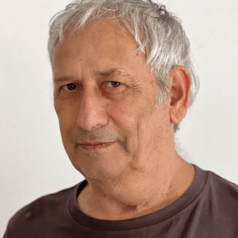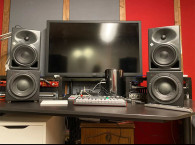The dynamic loudspeaker as we still know it today was invented in 1925 by Edward W. Kellogg and Chester W. Rice who were issued US Patent 1,707,570 on April 2, 1929. In the patent, they described a cylindrical coil being immersed in a magnetic field, attached to a suspended cone, forced to vibrate by alternating current flowing through the coil thus creating sound waves.

This basic construction did not change much during the last century, although materials and design techniques have improved
their performance a lot since it was widely used in radio receivers. However, from the start of loudspeaker research, it was clear that something had to be done with the sound wave coming from the back of the cone to prevent interference with the front wave.
Passive Bass Enhancement Methods
In 1954, Edgar Villchur developed the acoustic suspension principle. His sealed-box concept eliminated the back wave interference. The air trapped in the box was acting as a spring and together with the cone mass and acoustic resistance performed as a classic second-order system and when correctly calculated produced acceptable bass out of small, sealed-box speakers.
The “Bass reflex” or “ported box” principle was followed by enhanced bass in even smaller enclosures using a “Helmholtz resonator” port. Air mass trapped in a short tube open at both ends resonated with the compliance of the air volume in the speaker box and 180° phase shift of the speaker’s back wave could be obtained at a narrow range. When the resonator is tuned to a low frequency below the speaker’s resonance, the emitted sound from the port is summed with the speaker’s front wave.
In 1961, A. N. Thiele published an electro-mechanical loudspeaker model analysis. Following him and other researchers, in June 1972, Richard H. Small published a series of articles on loudspeaker design and analysis theory including closed-box, vented-box, and passive-radiator loudspeaker systems. That basic theory was successfully implemented with further adjustments and is still used as a woofer/enclosure optimization tool in various forms of computer-aided design.
A quarter-wave length transmission line for phase reversal of the speaker’s back wave was also widely used for bass enhancement without significant benefits in terms of speaker size or sound quality.
All these methods are based on a narrow band method for back wave phase reversal. Although current design optimization tools can achieve significant bass extension, the bass notes still come out from a narrowband source with the drawback of sustained, slow transient response leading to perceived boomy, smeared, or boxy sound.


Active Bass Enhancement Technologies
The loudspeaker industry achieved excellent results in the midrange and high-frequency ranges with ongoing improvements of materials and design concepts, however, the challenge of high-quality bass reproduction with small-size speakers remains.
Modern filter theory and digital signal processing (DSP) enabled smart equalization of the low-frequency range. Flat frequency response can be achieved with a driver in a small sealed or ported box. However, this concept does not take care of the nonlinearity that is inherent to air compression, driver’s magnetics, and suspension. Severe distortion is apparent at low-frequency high-excursion levels—therefore only a few loudspeaker makers use bass equalization with less than acceptable distortion and transient response.
DSP-powered feed forward combined with load current sensing by smart amplifiers have been intensively investigated by Dr. Wolfgang Klippel and other research groups with encouraging results.
These methods rely on the driver’s linear and nonlinear parameter characterization. Manufacturing consistency and material aging issues are critical for effective commercial implementation, therefore wide acceptance by manufacturers will take time.
Spatial sound, smart speakers, soundbars, and other consumer products have become massively popular in recent years with size and sound quality being a significant differentiator between brands. High-quality bass reproduction is part of it and passive bass enhancement methods cannot fulfill these requirements.
No doubt, DSP-powered technologies will eventually generate excellent results but engineering and implementation will take time. Many patents are being issued on the subject and speaker manufacturers will have to license the technology and probably need to buy DSP modules based on custom-made chips from a few vendors that will own these patents and dominate the supply.
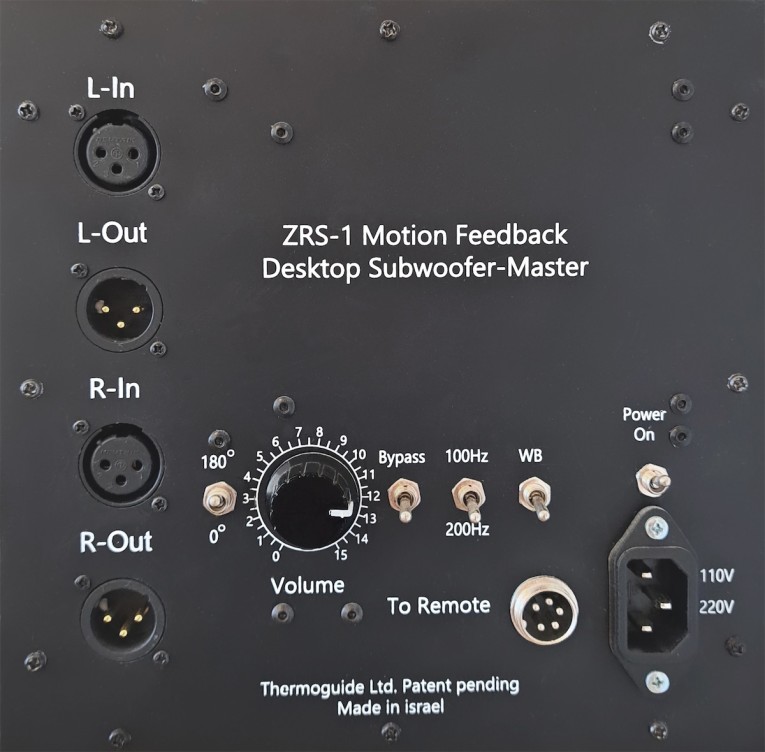
Motion Feedback Bass Enhancement History
Another well-known but almost forgotten bass enhancement method is motion feedback (MFB) also known as servo bass control. This method attracted lots of interest when Philips published its MFB technology article in 1968. In the early 1970s, Philips introduced its MFB-enabled RH544 bookshelf speakers with 200mm woofer in a ~10-liter air volume sealed box that was specified down to 30Hz. This was followed by the RH545 Studio monitor with a 12” woofer in ~50-liter air volume sealed box specified down to 20Hz.
The MFB concept was invented much earlier. However, these RH544 and RH545 speakers were the first commercial implementation with revolutionary deep tightly controlled bass notes reproduced from a relatively small, sealed box. Their MFB implementation was based on a custom-made piezo sensor attached to the woofer’s voice coil, feeding back real-time cone acceleration to an error amplifier, thus controlling the woofer’s dynamics.
Although the sound was much appreciated by consumers and sound engineers, Philips stopped making these loudspeakers because customers wanted passive speakers with their choice of amplifiers. Also, the manual assembly of discrete component circuits of the 1970s turned out to be too expensive to generate a profit.
Since that time, MFB has received lots of research attention from private inventors and leading audio companies. Capacitive, magnetic, and optic position sensors, second-winding velocity sensors, MEMS and piezo accelerometers were proposed as solutions for sensing the woofer’s dynamics for error correction. Many MFB-related patents were issued, but all of them have been abandoned or expired after 20 years.
A few manufacturers implemented MFB in commercial speakers, especially in active floor-standing subwoofers. Just to name a few, Velodyne Acoustics, Infinity, and Grimm Audio used acceleration sensors. Rythmik Audio used a second coil as velocity sensor. Others tried to use MFB and failed to get the loop stability, distortion, and noise performance. Somehow, MFB technology has always been considered complicated and expensive to implement. But is it really?
Increasingly, MFB is now getting attention from speaker vendors because the technology is all analog, mature, patent infringement-free, easy to understand, and easy to implement with current electronics and driver technology.
With MEMS accelerometers, Class-D power amps, switched-mode power supply (SMPS), and robust driver materials, MFB is simple, low cost, and easy to implement for deep bass reproduction by small drivers in small enclosures, thus saving cost and space. Small-size MFB subwoofers are especially attractive for production studios, home studios, bass guitar and electronic drum players, spatial sound installations, soundbars, and smart speakers.
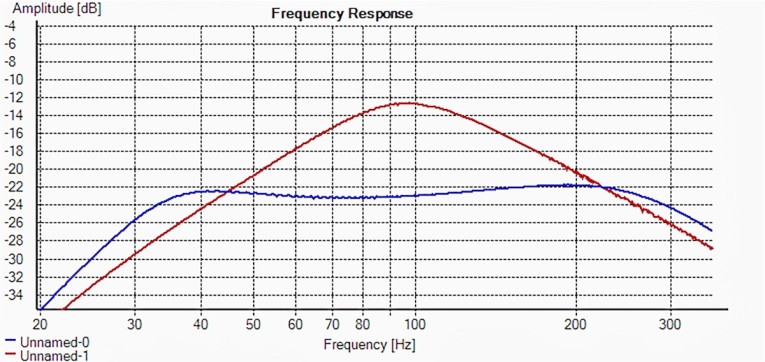
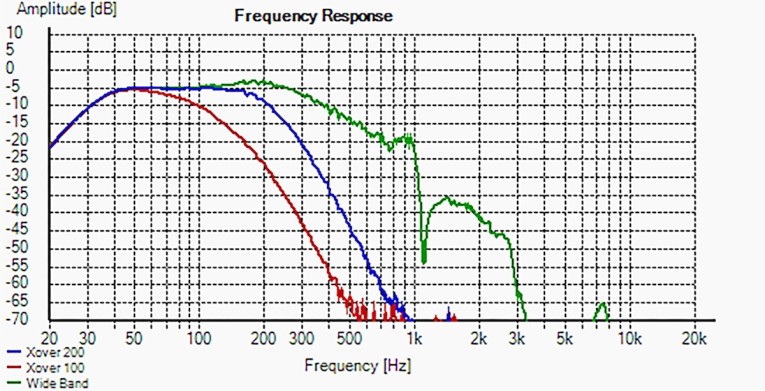
Small studio monitor speakers are widely used in home and professional production studios. Most of them are based on a two-way design with a 3.5" to 5" mid-bass driver in a ported enclosure and a tweeter. The monitor’s mid-bass driver parameters are selected to follow Thiele-Small (T-S) or similar design formulas. In most of the small monitors the midbass driver’s maximum excursion is compromised by the need to fulfill other required parameters.
When maximum excursion level is exceeded, the driver's nonlinearity can cause midrange modulation by the bass notes, compromising stereo image and clarity. Therefore, many small near field monitors roll off sharply and filter out the frequency range below 50Hz or 60Hz. Even with careful design, a ported monitor speaker is resonant, yielding sustained, over-hung low-frequency notes (boomy or boxy bass).
Adding a floor-standing subwoofer to complement studio monitors with the low-end frequency range causes room mode excitation and eventually although carefully placed, even high-priced studio grade subwoofers often do not blend well with studio monitors.
Thermoguide took the challenge and invested 3 years of research to create a small subwoofer that would complement small studio monitors. The goal was to create a small desktop subwoofer as a desktop add-on product. It was clear that traditional bass enhancement methods could not cope with the acceptable size, therefore MFB was selected as a potential technology for this project.
Eventually, Thermoguide engineered and built six prototypes of the ZRS-1 MFB Desktop Subwoofer. The subwoofers measure 20cm×20cm×20cm and were intended to be placed underneath any small studio monitor to add the most desired 30Hz to 60Hz range, while blending in with the monitor’s response, by having a common acoustic wave front.
An accelerometer-based MFB was chosen to demonstrate the feasibility of the ZRS-1 MFB design as a small near-field desktop subwoofer. The MDF enclosure contains the MFB control circuit, fourth-order Linkwitz-Riley crossover filters, a switching power supply, and a powerful Class-D amplifier, all designed and integrated for these subwoofers.
The driver, a simple, off-the-shelf, 6” long-throw woofer was modified with an accelerometer bonded on the driver’s voice coil former. Based on driver measurements and control theory, MFB loop parameters were set for flat frequency response of 20Hz to 400Hz.
A real-time voice coil temperature protection circuit was implemented to keep the voice coil temperature below 125°C during overstressed operation. And an overload warning circuit was designed to sense the amplifier’s output voltage and turn a red light on when reaching close to the power supply rails.
The block diagram in Figure 1 shows the basic features of the prototype design. The subwoofer was designed to be used in full stereo configuration, but it can also be configured as a single subwoofer feeding two monitors. In this configuration, Left and Right low frequency signals are summed for the subwoofer.
The custom-designed plate amplifier (Photo 1) includes a 1kW peak Class-D power amplifier module, a 500W SMPS, MFB servo control loop, 24dB/octave Linkwitz-Riley crossover, real-time voice coil thermal protection, and studio-ready XLR in/out connectors. All these electronic circuits were integrated on a
20cm×20cm plate amplifier that can fit into a 20cm×20cm×20cm cube (Photo 2).
These plate amplifiers can be matched to any driver size in any sealed box size just by selecting a few control parameters. For that purpose, we also designed custom-made acceleration sensors that can fit any voice coil diameters from 12mm to 50mm, and to match with the plate amplifier.

With the subwoofer’s frequency range from 30Hz to 300Hz, the crossover from the subwoofer to the monitor can be set to 100Hz or 200Hz, thus freeing the monitor to produce only the mid- and high-frequency range and minimize bass-midrange intermodulation.
The combination practically forms a three-way desktop system with a powerful bass extension. Photo 3 shows a demonstration of the ZRS-1 MFB desktop subwoofers with the Genelec monitors at the IPS High End show in Munich 2023.
The ZRS-1 subwoofer (with 4 liters of internal air volume) responds flat from 30Hz to 300Hz with a powerful fast transient response. Total harmonic distortion (THD) and third harmonics are reduced by more than 10dB in the high excursion range of 30Hz to 60Hz thus the subwoofer can be driven to a higher SPL than what would be possible with an open-loop equalized speaker. By filtering out the bass range, any small monitor can be driven to a much higher SPL than specified by the manufacturer. This setup make the Desktop Subwoofers ideal for nearfield listening in home studios and even professional production studios.
Gamers, bass guitar players, and other musicians, all can benefit from the powerful fast transient, effortless bass, and small size. Another advantage of the desktop format is that direct nearfield listening to subwoofers significantly mitigates room modes, because the reflected sound is attenuated compared to the direct sound. The result is that bass notes sound the same in different environments, less sensitive to room size, acoustic treatment, or desk location.
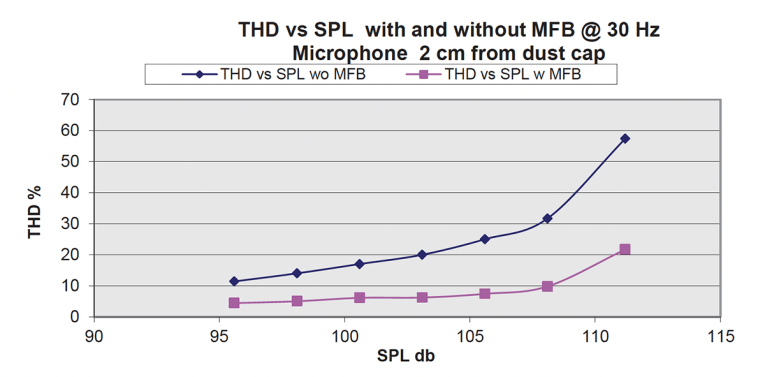
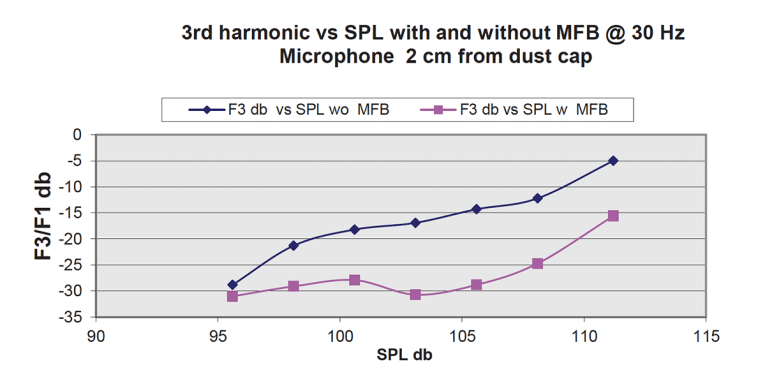
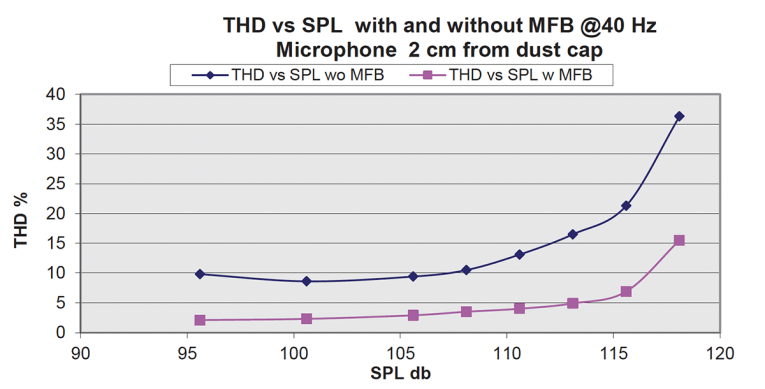
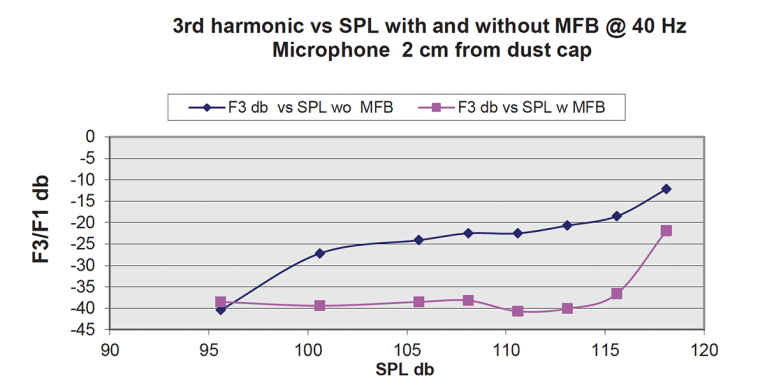
Other than flattening the frequency response down to the bottom audible range, being a negative feedback method, MFB significantly reduces nonlinear distortion. The ZRS-1 Desktop Subwoofer measurement plots (Figures 2-7) show frequency response, THD, and third-harmonic attenuation vs. SPL.
The results show that with a driver in a small, sealed box, when driven by high excursion low frequencies, the MFB-enabled solution can generate up to 10dB more SPL for a given distortion level compared to the same driver in the same box driven to the same fundamental tone SPL without MFB. aX
Resources
Thermoguide, Ltd. | Servobass
www.servobass.com
This article was originally published in audioXpress, November 2023


